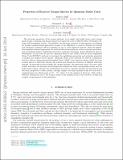| dc.contributor.author | Zen, Andrea | |
| dc.contributor.author | Trout, Bernhardt L. | |
| dc.contributor.author | Guidoni, Leonardo | |
| dc.date.accessioned | 2014-11-14T19:13:48Z | |
| dc.date.available | 2014-11-14T19:13:48Z | |
| dc.date.issued | 2014-07 | |
| dc.identifier.issn | 0021-9606 | |
| dc.identifier.issn | 1089-7690 | |
| dc.identifier.uri | http://hdl.handle.net/1721.1/91583 | |
| dc.description.abstract | The electronic properties of the oxygen molecule, in its singlet and triplet states, and of many small oxygen-containing radicals and anions have important roles in different fields of chemistry, biology, and atmospheric science. Nevertheless, the electronic structure of such species is a challenge for ab initio computational approaches because of the difficulties to correctly describe the statical and dynamical correlation effects in presence of one or more unpaired electrons. Only the highest-level quantum chemical approaches can yield reliable characterizations of their molecular properties, such as binding energies, equilibrium structures, molecular vibrations, charge distribution, and polarizabilities. In this work we use the variational Monte Carlo (VMC) and the lattice regularized Monte Carlo (LRDMC) methods to investigate the equilibrium geometries and molecular properties of oxygen and oxygen reactive species. Quantum Monte Carlo methods are used in combination with the Jastrow Antisymmetrized Geminal Power (JAGP) wave function ansatz, which has been recently shown to effectively describe the statical and dynamical correlation of different molecular systems. In particular, we have studied the oxygen molecule, the superoxide anion, the nitric oxide radical and anion, the hydroxyl and hydroperoxyl radicals and their corresponding anions, and the hydrotrioxyl radical. Overall, the methodology was able to correctly describe the geometrical and electronic properties of these systems, through compact but fully-optimised basis sets and with a computational cost which scales as N 3 − N 4, where N is the number of electrons. This work is therefore opening the way to the accurate study of the energetics and of the reactivity of large and complex oxygen species by first principles. | en_US |
| dc.description.sponsorship | European Union (7th Framework Programme, European Research Council Project MultiscaleChemBio (No. 240624)) | en_US |
| dc.description.sponsorship | Singapore-MIT Alliance | en_US |
| dc.language.iso | en_US | |
| dc.publisher | American Institute of Physics | en_US |
| dc.relation.isversionof | http://dx.doi.org/10.1063/1.4885144 | en_US |
| dc.rights | Creative Commons Attribution-Noncommercial-Share Alike | en_US |
| dc.rights.uri | http://creativecommons.org/licenses/by-nc-sa/4.0/ | en_US |
| dc.source | arXiv | en_US |
| dc.title | Properties of reactive oxygen species by quantum Monte Carlo | en_US |
| dc.type | Article | en_US |
| dc.identifier.citation | Zen, Andrea, Bernhardt L. Trout, and Leonardo Guidoni. “Properties of Reactive Oxygen Species by Quantum Monte Carlo.” The Journal of Chemical Physics 141, no. 1 (July 7, 2014): 014305. | en_US |
| dc.contributor.department | Massachusetts Institute of Technology. Department of Chemical Engineering | en_US |
| dc.contributor.mitauthor | Trout, Bernhardt L. | en_US |
| dc.relation.journal | Journal of Chemical Physics | en_US |
| dc.eprint.version | Author's final manuscript | en_US |
| dc.type.uri | http://purl.org/eprint/type/JournalArticle | en_US |
| eprint.status | http://purl.org/eprint/status/PeerReviewed | en_US |
| dspace.orderedauthors | Zen, Andrea; Trout, Bernhardt L.; Guidoni, Leonardo | en_US |
| dc.identifier.orcid | https://orcid.org/0000-0003-1417-9470 | |
| mit.license | OPEN_ACCESS_POLICY | en_US |
| mit.metadata.status | Complete | |
